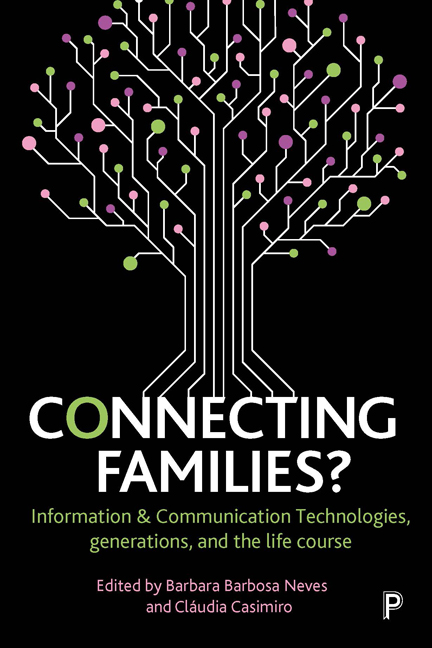Book contents
three - Recursive approaches to technology adoption, families, and the life course: actor network theory and strong structuration theory
Published online by Cambridge University Press: 22 April 2022
Summary
Introduction
While numerous models are used to explain technology adoption (such as the widely used technology acceptance model and its several variants), we still await a comprehensive framework that integrates technological materiality, the situation of its implementation, and users’ expectations and experiences. The absence is especially glaring when we consider technology domestication in the sphere of the family and adoption across the life course (Dourish, 2004; Chuttur, 2009; Neves et al, 2017a, 2017b). This chapter seeks to address this absence by considering two ‘recursive’ approaches, which examine the reciprocal relationship between social structure and agency in the context of technology use over time. The recursive approaches under consideration are particularly useful given their integrative and situational sensitivity, focusing as they do on the intersection of users, contexts, and technologies (Greenhalgh and Stones, 2010). Here, we consider two approaches, adapted to the domain of digital technology: actor network theory (ANT) and strong structuration theory (SST).
ANT has emerged under the social shaping theories approach, within science and technology studies, as a response to technological determinism (MacKenzie and Wajcman, 1999). Technological determinism posits that technology is the cause of social change and that its development occurs independently of social, economic, cultural, and political forces, that is, ‘outside of society’ (MacKenzie and Wajcman, 1999; Wyatt, 2008). For instance, to define a civilization by its dominant technological artefacts (such as stone, iron, cars, microelectronics,) is to treat technology as independent of societal forces except insofar as it generates them (Wyatt, 2008). ANT draws on this critique but goes further by rejecting any form of determinism, whether technological or social (particularly those studies undertaken from a ‘social construction of technology’ perspective). The focus of ANT is on the tracing of associations between entities – whether these entities are human or non-human. The ‘symmetrical’ approach that actor network theorists adopt entails the avoidance of any such discrimination. Hence, it informs a non-dualist account of technology and society that avoids essentialized notions of ‘the social’ or technology. Our second approach, SST, begins in a formal sociological inquiry into recurrent patterns or structures and the place of agency therein. The rise of ANT compelled strong structuration theorists to consider the role of technology among the relations between agency and social structure.
- Type
- Chapter
- Information
- Connecting Families?Information and Communication Technologies, Generations, and the Life Course, pp. 41 - 58Publisher: Bristol University PressPrint publication year: 2018
- 2
- Cited by

